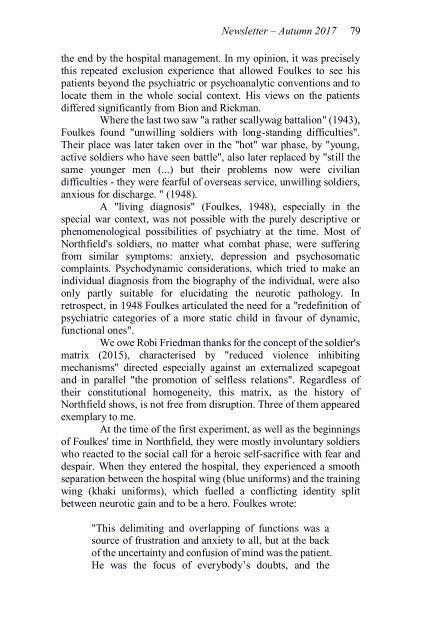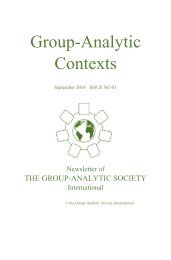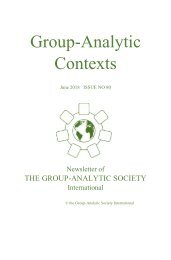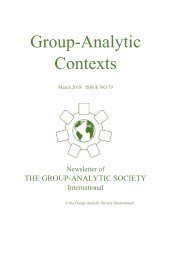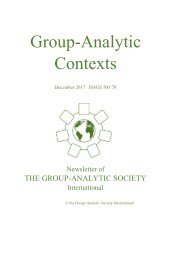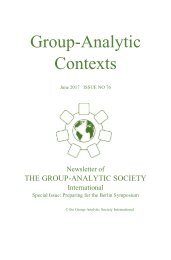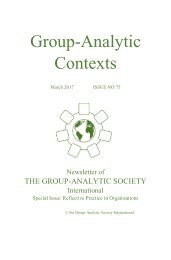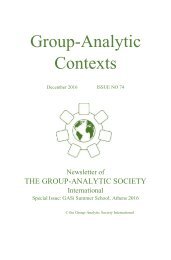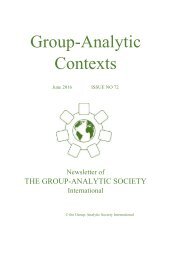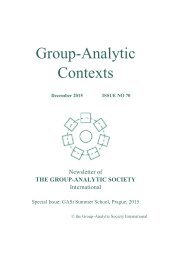Group Analytic Contexts, Issue 77, September 2017
Newsletter of the Group Analytic Society International
Newsletter of the Group Analytic Society International
Create successful ePaper yourself
Turn your PDF publications into a flip-book with our unique Google optimized e-Paper software.
Newsletter – Autumn <strong>2017</strong> 79<br />
the end by the hospital management. In my opinion, it was precisely<br />
this repeated exclusion experience that allowed Foulkes to see his<br />
patients beyond the psychiatric or psychoanalytic conventions and to<br />
locate them in the whole social context. His views on the patients<br />
differed significantly from Bion and Rickman.<br />
Where the last two saw "a rather scallywag battalion" (1943),<br />
Foulkes found "unwilling soldiers with long-standing difficulties".<br />
Their place was later taken over in the "hot" war phase, by "young,<br />
active soldiers who have seen battle", also later replaced by "still the<br />
same younger men (...) but their problems now were civilian<br />
difficulties - they were fearful of overseas service, unwilling soldiers,<br />
anxious for discharge. " (1948).<br />
A "living diagnosis" (Foulkes, 1948), especially in the<br />
special war context, was not possible with the purely descriptive or<br />
phenomenological possibilities of psychiatry at the time. Most of<br />
Northfield's soldiers, no matter what combat phase, were suffering<br />
from similar symptoms: anxiety, depression and psychosomatic<br />
complaints. Psychodynamic considerations, which tried to make an<br />
individual diagnosis from the biography of the individual, were also<br />
only partly suitable for elucidating the neurotic pathology. In<br />
retrospect, in 1948 Foulkes articulated the need for a "redefinition of<br />
psychiatric categories of a more static child in favour of dynamic,<br />
functional ones".<br />
We owe Robi Friedman thanks for the concept of the soldier's<br />
matrix (2015), characterised by "reduced violence inhibiting<br />
mechanisms" directed especially against an externalized scapegoat<br />
and in parallel "the promotion of selfless relations". Regardless of<br />
their constitutional homogeneity, this matrix, as the history of<br />
Northfield shows, is not free from disruption. Three of them appeared<br />
exemplary to me.<br />
At the time of the first experiment, as well as the beginnings<br />
of Foulkes' time in Northfield, they were mostly involuntary soldiers<br />
who reacted to the social call for a heroic self-sacrifice with fear and<br />
despair. When they entered the hospital, they experienced a smooth<br />
separation between the hospital wing (blue uniforms) and the training<br />
wing (khaki uniforms), which fuelled a conflicting identity split<br />
between neurotic gain and to be a hero. Foulkes wrote:<br />
"This delimiting and overlapping of functions was a<br />
source of frustration and anxiety to all, but at the back<br />
of the uncertainty and confusion of mind was the patient.<br />
He was the focus of everybody’s doubts, and the


